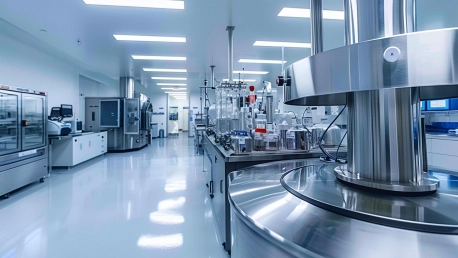As the first quarter of 2024 closed, the biopharma sector wasn’t just riding the wave of excitement that accompanies groundbreaking scientific discoveries—it was also navigating the tumultuous waters of the financial markets. With M&A activity surging by a staggering 71 percent in “mega deals,” the industry’s financial landscape is rapidly evolving. Unprecedented investments are pumping into companies, hinting at strategic maneuvering to overcome the hurdles posed by legislative changes and impending patent cliffs.
Resurgence of Mega M&A Activities in Biopharma
Drivers Behind the Surge in M&A
The recent uptick in merger and acquisition activity within the biopharma sector is not accidental. It is a calculated response to imminent industry disruptions such as the Inflation Reduction Act and a barrage of upcoming patent expirations that threaten to curtail revenues. Companies are seeking to consolidate, aiming to offset potential losses by expanding their portfolios and securing a competitive edge. The feverish deal-making also reflects revived confidence in long-term strategic investments, as leaders in the industry prepare to navigate a landscape altered by regulatory and market forces. The arrival of the Inflation Reduction Act, which aims to rein in drug prices, has only accelerated the need for biopharma giants to realign their strategic objectives. The specter of patent cliffs looms large, forcing companies to innovate or acquire novel therapies that promise fresh revenue streams. As big players look to shore up their defenses against these challenges, mega-mergers and acquisitions have emerged as the go-to strategy for maintaining market dominance and fostering growth.
Analyzing the Top Deals of Q1 2024
The largest transaction of the first quarter undeniably shaped the industry’s direction. Novo Holdings’ acquisition of Catalent for $16.5 billion wasn’t just a headline-grabbing event—it was a strategic leap. Catalent’s capabilities in biologics, gene therapies, and drugs stand to enhance Novo Holdings’ already formidable market presence. Meanwhile, Gilead Sciences made a significant move by acquiring CymaBay Therapeutics for $4.3 billion, underscoring the industry’s appetite for expansion into liver disease treatments. These mega deals are more than financial gambits; they represent shrewd positioning for future growth.
Strategic Focus Areas in Recent Biopharma M&As
Investment in Advanced Therapeutics
Biopharma’s recent M&A decisions reveal a keen focus on cutting-edge therapies, particularly antibody-drug conjugates (ADCs) and radiopharmaceuticals, which have become attractive assets for larger companies seeking to diversify. These investments are not random bets but carefully chosen for their potential to revolutionize treatment paradigms. ADCs, for example, promise to harness the precision of monoclonal antibodies and the potency of chemotherapy, while radiopharmaceuticals open avenues for highly targeted radiation therapy. Through acquisitions, big pharma firms are ensuring they stay at the vanguard of these innovative approaches, fortifying their arsenals against disease with the next generation of therapeutic weapons.
The Continued Dominance of Oncology and Rise of Immunology
Oncology remains the cornerstone of M&A interests, commanding an impressive $29 billion. The unwavering focus on cancer treatment reflects the sector’s recognition of the unmet medical need and the opportunity it presents for return on investment. Meanwhile, immunology has emerged from the shadows to display an astounding 314 percent increase in deal value year-on-year, with firms investing heavily into therapies that modulate the immune system. This sharp rise signifies the recognition of immunology’s potential to alter the landscape of various diseases, fueling a rush to claim stakes in a field ripe with promise.
The Phenomenal Growth of GLP-1 Receptor Agonists
Market Expansion Fueled by Obesity and Diabetes Management
The GLP-1 receptor agonist class of drugs has seen an explosion in popularity, largely due to their dual role in managing type 2 diabetes and obesity. FDA nods have played a pivotal role in this narrative, expanding the market reach of drugs like Ozempic and Mounjaro significantly. Sales figures speak volumes—with Ozempic raking in approximately $4 billion alone in Q1 2024—underscoring the market pull of these drugs. The success of GLP-1 receptor agonists also opens the door for further innovation in a market already brimming with potential.
Clinical Advancements Reinforcing Drug Efficacy
Ongoing clinical trials like the Phase III FLOW study continue to bolster the standing of GLP-1 receptor agonists, with semaglutide showing remarkable effects on kidney function and reducing risks of cardiovascular or renal death. These promising results are not just a boon for patients but also for the companies that own these drugs, solidifying their position in the market. The high stakes attached to the efficacy and safety of these drugs indicate their potential to redefine treatment protocols for chronic conditions, enhancing the quality of life for millions while expanding the market footprint of biopharma firms.
Innovations Shaping Diabetes and Obesity Treatment
The Arrival of Next-Generation Drugs
The pipeline of diabetes and obesity treatments is brimming with promise as next-generation drugs like Novo Nordisk’s CagriSema and Lilly’s orforglipron make their way to the forefront. These innovations, more than mere replacements for existing therapies, signal a leap forward in treatment effectiveness and patient outcomes. With CagriSema already achieving the status of biopharma’s most valued R&D project in 2024, the excitement around these drugs teases an impending transformation in the market, one that could heighten the dominance of leading companies.
Overcoming Market Challenges
However, this golden era for GLP-1 receptor agonists is not without its obstacles. Supply shortages and steep costs are significant deterrents, creating barriers to patient access. Overcoming these hurdles is essential, not only to ensure patients receive the care they need but also to unlock the full market potential of these drugs. As biopharma companies grapple with these issues, their resolution could dramatically broaden the patient pool and catapult the market to unprecedented heights.
The Evolving Role of AI and Big Data in Biopharma
Revolutionizing Drug Development with AI
Artificial intelligence is rapidly reshaping the biopharma landscape, from drug discovery to patient outcomes. Utilizing AI and big data analytics, companies are streamlining R&D processes, predicting molecular behavior, and customizing treatments for better efficacy. The potential of AI extends far beyond drug development; it is poised to redefine every facet of the industry, revolutionizing the way medications are brought to market and how patient care is administered.
Leveraging AI Across the Biopharma Value Chain
The transformative power of AI doesn’t stop at the lab door. It pervades the entire value chain of biopharma, from expediting research to advancing the accuracy of safety data processing. The concept of digital twins—virtual simulations of drugs and trials—promises to slash the time-to-market for new therapeutics, offering a glimpse into an era of unparalleled efficiency and innovation. As the biopharma sector leans into this new technological frontier, the benefits of AI’s predictive prowess will continue to unfold.
Perspectives on 2024 and Beyond
Mega M&As and Their Strategic Impact
Mega mergers and acquisitions are decisively altering the corporate strategies within biopharma. They are the catalysts for a significant reconfiguration of the industry, carving out a future that is both more integrated and aggressively positioned for growth. The strategic ripples of these transactions are set to shape how companies operate, wield influence, and manifest their vision for a healthier world. From showcasing strategic foresight to altering competitive dynamics, mega M&As are the engines driving biopharma into a bold, new era.
Technological Innovation Leading the Charge
As Q1 of 2024 came to a close, the biopharma industry found itself simultaneously at an exciting and challenging crossroads. On one hand, it was buoyed by the thrill of innovative scientific breakthroughs that promised to reshape healthcare. On the other, it faced the rough seas of a volatile financial market. Key to navigating these challenges was a notable surge in M&A activities — “mega deals” saw an increase by a remarkable 71 percent, signaling a shift in the sector’s financial dynamics.









